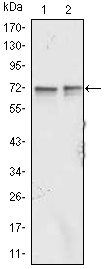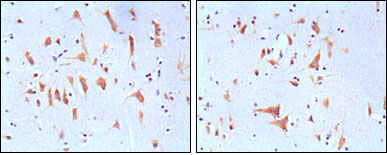FMR1 Monoclonal Antibody
- Catalog No.:YM0280
- Applications:WB;IHC;IF;ELISA
- Reactivity:Human
- Target:
- FMR1
- Gene Name:
- FMR1
- Protein Name:
- Fragile X mental retardation 1 protein
- Human Gene Id:
- 2332
- Human Swiss Prot No:
- Q06787
- Mouse Swiss Prot No:
- P35922
- Immunogen:
- Purified recombinant fragment of human FMR1 expressed in E. Coli.
- Specificity:
- FMR1 Monoclonal Antibody detects endogenous levels of FMR1 protein.
- Formulation:
- Liquid in PBS containing 50% glycerol, 0.5% BSA and 0.02% sodium azide.
- Source:
- Monoclonal, Mouse
- Dilution:
- WB 1:500 - 1:2000. IHC 1:200 - 1:1000. IF 1:200 - 1:1000. ELISA: 1:10000. Not yet tested in other applications.
- Purification:
- Affinity purification
- Storage Stability:
- -15°C to -25°C/1 year(Do not lower than -25°C)
- Other Name:
- FMR1;Fragile X mental retardation protein 1;FMRP;Protein FMR-1
- Molecular Weight(Da):
- 71kD
- References:
- 1. BMC Mol Biol. 2008 Oct 15;9:89.
2. Fertil Steril. 2008 Oct 28.
- Background:
- The protein encoded by this gene binds RNA and is associated with polysomes. The encoded protein may be involved in mRNA trafficking from the nucleus to the cytoplasm. A trinucleotide repeat (CGG) in the 5' UTR is normally found at 6-53 copies, but an expansion to 55-230 repeats is the cause of fragile X syndrome. Expansion of the trinucleotide repeat may also cause one form of premature ovarian failure (POF1). Multiple alternatively spliced transcript variants that encode different protein isoforms and which are located in different cellular locations have been described for this gene. [provided by RefSeq, May 2010],
- Function:
- alternative products:At least 12 different isoforms are produced,disease:Defects in FMR1 are the cause of fragile X syndrome. [MIM:300624]. It is a common genetic disease (has a prevalence of one in every 2000 children) which is characterized by moderate to severe mental retardation, macroorchidism (enlargement of the testicles), large ears, prominent jaw, and high-pitched, jocular speech. The defect in most fragile X syndrome patients results from an amplification of a CGG repeat region which is directly in front of the coding region.,disease:Defects in FMR1 are the cause of fragile X tremor/ataxia syndrome (FXTAS) [MIM:300623]. In FXTAS, the expanded repeats range in size from 55 to 200 repeats and are referred to as 'premutations'. Full repeat expansions with greater than 200 repeats results in fragile X mental retardation syndrome [MIM:300624]. Carriers of the premutation typically d
- Subcellular Location:
- Nucleus . Nucleus, nucleolus . Chromosome, centromere . Chromosome . Cytoplasm . Cytoplasm, perinuclear region . Cytoplasm, Cytoplasmic ribonucleoprotein granule . Perikaryon . Cell projection, neuron projection . Cell projection, axon . Cell projection, dendrite . Cell projection, dendritic spine . Cell junction, synapse, synaptosome . Cell projection, growth cone . Cell projection, filopodium tip . Cell junction, synapse . Cell junction, synapse, postsynaptic cell membrane . Cell junction, synapse, presynaptic cell membrane . Cell membrane . Cytoplasm, Stress granule . Colocalizes with H2AX/H2A.x in pericentromeric heterochromatin in response to DNA damaging agents (By similarity). Localizes on meiotic pachytene-stage chromosomes (By similarity). Forms nuclear foci representing sites of
- Expression:
- Expressed in the brain, cerebellum and testis (PubMed:8401578). Also expressed in epithelial tissues (PubMed:8401578). Expressed in mature oligodendrocytes (OLGs) (PubMed:23891804). Expressed in fibroblast (PubMed:24204304). Expressed in neurons, Purkinje cells and spermatogonias (at protein level) (PubMed:8401578). Expressed in brain, testis and placenta (PubMed:8504300). Expressed in neurons and lymphocytes (PubMed:8504300).
- June 19-2018
- WESTERN IMMUNOBLOTTING PROTOCOL
- June 19-2018
- IMMUNOHISTOCHEMISTRY-PARAFFIN PROTOCOL
- June 19-2018
- IMMUNOFLUORESCENCE PROTOCOL
- September 08-2020
- FLOW-CYTOMEYRT-PROTOCOL
- May 20-2022
- Cell-Based ELISA│解您多样本WB检测之困扰
- July 13-2018
- CELL-BASED-ELISA-PROTOCOL-FOR-ACETYL-PROTEIN
- July 13-2018
- CELL-BASED-ELISA-PROTOCOL-FOR-PHOSPHO-PROTEIN
- July 13-2018
- Antibody-FAQs
- Products Images

- Western Blot analysis using FMR1 Monoclonal Antibody against Jurkat (1) and K562 (2) cell lysate.

- Immunohistochemistry analysis of paraffin-embedded human brain tissues, showing cytoplasmic localization with DAB staining using FMR1 Monoclonal Antibody.

- Immunofluorescence analysis of NIH/3T3 cells using FMR1 Monoclonal Antibody (green). Blue: DRAQ5 fluorescent DNA dye. Red: Actin filaments have been labeled with Alexa Fluor-555 phalloidin.



